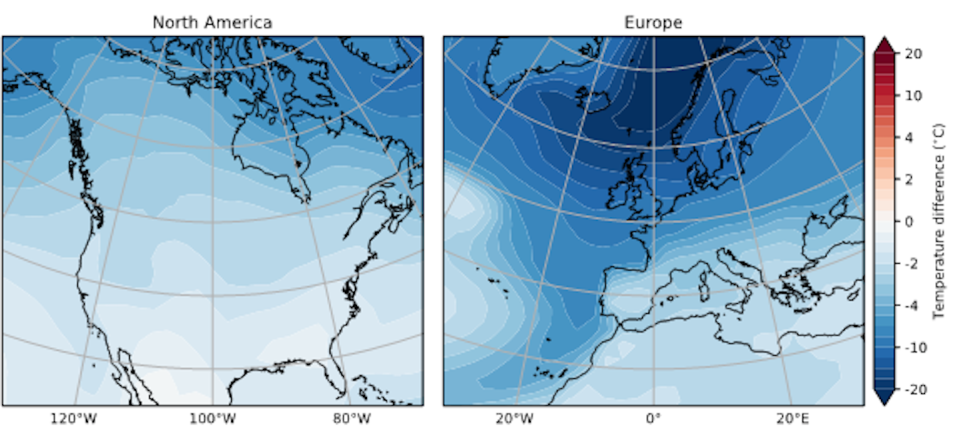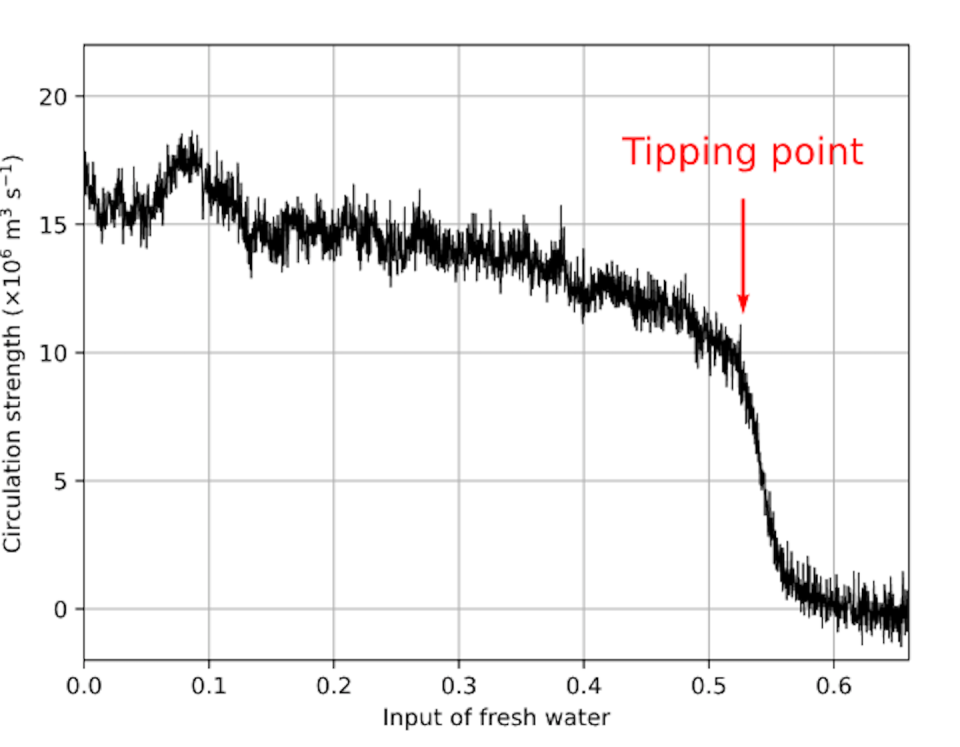Superstorms, sudden climate changes, and New York City is covered in ice. This is how the blockbuster Hollywood movie “The Day After Tomorrow” depicted the sudden closure of the circulation of the Atlantic Ocean and its disastrous consequences.
While Hollywood’s vision was at its peak, the 2004 film raised a serious question: How sudden and severe would climate changes be if global warming shut down the Atlantic Meridional Overturning Circulation, which is vital in transporting heat from the tropics to northern latitudes? ?
Twenty years after the film’s release, we know much more about the circulation of the Atlantic Ocean. Instruments deployed in the ocean starting in 2004 show that the Atlantic Ocean circulation has slowed noticeably over the past two decades, possibly reaching its weakest state in almost a millennium. Studies also suggest that circulation reached a dangerous tipping point in the past, sending it into a sudden, unstoppable decline, and that it may reach that tipping point again as the planet warms and glaciers and ice sheets melt.
In a new study using the latest generation of Earth climate models, we simulated freshwater flow until ocean circulation reached this tipping point.
The results showed that after reaching the tipping point, circulation could stop completely within a century and was heading in that direction. If this were to happen, average temperatures in North America, parts of Asia, and Europe would drop by several degrees, and people would face serious and gradual consequences worldwide.
We also discovered a physics-based early warning signal that could alert the world when the Atlantic Ocean circulation is approaching its tipping point.
ocean conveyor belt
Ocean currents are affected by winds, tides, and water density differences.
In the Atlantic Ocean circulation, relatively warm and salty surface water near the equator flows towards Greenland. During its journey, it crosses the Caribbean Sea, enters the Gulf of Mexico, and flows along the East Coast of the United States before crossing the Atlantic.

This current, also known as the Gulf Stream, brings warmth to Europe. As it flows north and cools, the water mass becomes heavier. When it reaches Greenland, it begins to sink and flow southward. The sinking of water near Greenland draws water from elsewhere in the Atlantic Ocean, and the cycle repeats like a conveyor belt.
Too much freshwater from melting glaciers and the Greenland ice sheet can dilute the salinity of the water, preventing it from sinking and weakening this ocean conveyor belt. A weaker conveyor belt carries less heat northward and also allows less heavy water to reach Greenland, further weakening the strength of the conveyor belt. Once it reaches the tipping point it quickly shuts down.
What happens to the climate at the tipping point?
The existence of a tipping point was first recognized in an oversimplified model of the Atlantic Ocean circulation in the early 1960s. Today’s more detailed climate models show that the power of the conveyor belt is steadily slowing down due to climate change. However, in these climate models, it was seen that a sudden stop of the Atlantic Ocean circulation was out of the question.
This is where our study comes into play. We ran an experiment with a detailed climate model to find the tipping point for a sudden shutdown by gradually increasing freshwater input.
We have seen the conveyor belt shut down within 100 years when it reaches the tipping point. Heat transfer towards the north decreases greatly, leading to sudden climate changes.
Result: dangerous cold in the North
Regions affected by the Gulf Stream receive significantly less heat when circulation ceases. This cools the continents of North America and Europe by several degrees.
The European climate is much more affected by the Gulf Stream than other regions. In our experiment, this meant that parts of the continent warmed by more than 5 degrees Fahrenheit (3 degrees Celsius) per decade; This was much faster than today’s global warming of about 0.36 F (0.2 C) per decade. We found that some parts of Norway will experience temperature drops of more than 36 F (20 C). On the other hand, regions in the Southern Hemisphere will warm up by a few degrees.


These temperature changes develop over approximately 100 years. This may seem like a long time, but on typical climate time scales it is an abrupt process.
Closing the conveyor belt could also affect sea levels and rainfall patterns, pushing other ecosystems closer to tipping points. For example, the Amazon rainforest is vulnerable to decreasing rainfall. If the forest ecosystem converts to grassland, this transition will release carbon into the atmosphere and result in the loss of a valuable carbon sink, further accelerating climate change.
Atlantic circulation slowed down significantly in the distant past. During glacial periods, when ice sheets covering large parts of the planet melted, freshwater flows slowed the Atlantic circulation, triggering major climate fluctuations.
So when will we see this turning point?
The big question of when the Atlantic circulation will reach its tipping point remains unanswered. Observations do not go back far enough to give a clear conclusion. Although a recent study suggested that the conveyor belt was rapidly approaching the tipping point, possibly within a few years, these statistical analyzes made several assumptions that led to uncertainty.
Instead, we managed to develop a physics-based and observable early warning signal involving salinity transport across the southern boundary of the Atlantic Ocean. Once a threshold is reached, the tipping point is likely to come within one to forty years.


The climate implications of our study highlight the severity of such a sudden conveyor belt collapse. Changes in temperature, sea level and precipitation will seriously affect society, and climate changes cannot be stopped on human time scales.
It may seem counterintuitive to worry about extreme cold as the planet warms, but if the main circulation of the Atlantic Ocean closes due to too much meltwater flowing through, that’s the risk ahead.
This article is republished from The Conversation, an independent, nonprofit news organization providing facts and authoritative analysis to help you understand our complex world. Written by René van Westen, Utrecht University; Henk A. Dijkstra, Utrecht Universityand Michael Kliphuis, Utrecht University
Read more:
René van Westen receives funding from the European Research Council (ERC-AdG project 101055096, TAOC).
Henk A. Dijkstra receives funding from the European Research Council (ERC-AdG project 101055096, TAOC, PI: Dijkstra).
Michael Kliphuis does not work for, consult, own shares in, or receive funding from any company or organization that would benefit from this article, and has disclosed no relevant affiliations beyond his academic duties.